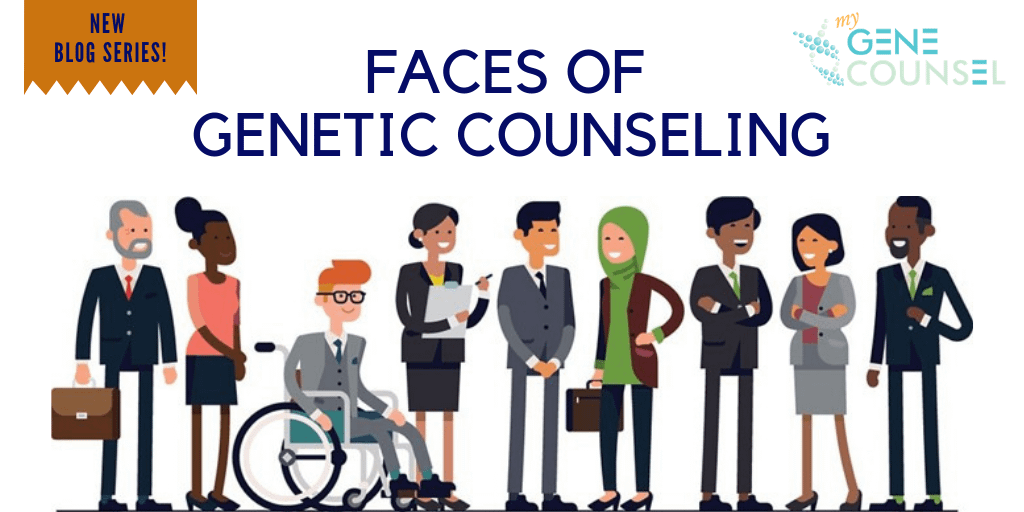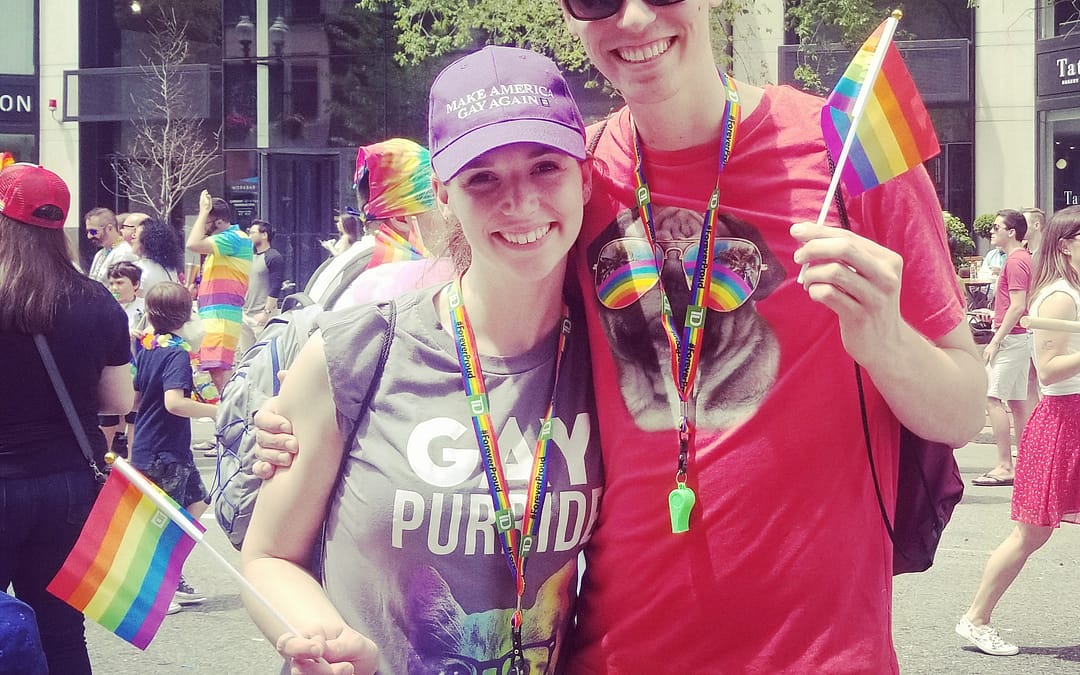
In the blog series, “Faces of Genetic Counseling”, we highlight genetic counselors who come from diverse backgrounds and serve as representatives and advocates within their field.

Diane Koeller, MS, MPH
For our first installment we had the opportunity of speaking with Diane Koeller, MS, MPH, LCGC a genetic counselor at the Dana-Farber Cancer Institute in Boston who works closely with the LGBTQIA+ community in a cancer clinic welcoming of transgender people. Diane is a pioneer in her field, working to understand the unique counseling needs and cancer risks for the transgender population and to develop standards of care across healthcare.

She is a recent graduate of the University of Michigan, where she specialized in Health Communication and Public Health Genetics. She is involved with the Cancer, Public Health, and Education Special Interest Groups within the National Society of Genetic Counselors (NSGC) and works to educate the public on the healthcare needs of transgender patients through publication, advocacy, and public presentation.
What led you to specialize in transgender genetic health?
I didn’t intend to specialize in this area, but my interest started with one particular patient. I am pansexual, my mother is in a same-sex marriage, and I’ve had close friends who belong to gender and sexual minority groups since childhood, so I’ve been involved in the LGBTQ community for a long time. But when I saw my first transgender patient, I realized how much I didn’t know about the medical side of caring for trans people. While most of my cisgender patients are terrified of carrying a mutation in a gene associated with breast cancer risk, this patient was hoping to test positive for a mutation in the BRCA1 gene (a breast cancer gene) to help him get insurance coverage for the removal of his breasts. Getting his breasts removed was a very important part of his gender affirmation, but his insurance company would not cover this procedure unless he had a high risk of breast cancer. He also wondered about hormones and how that would impact his risks for cancer, but I could find no literature to help answer his questions. When we discussed the possibility of him needing his ovaries removed for cancer risk reduction, I didn’t even think to ask about whether he wanted children because I knew so little about transgender parenthood. Seeing him made me realize how little training I had in working with transgender patients and that the resources available to help me learn were extremely limited. I realized there was an unmet need here. I become motivated to ensure that I was better prepared for my future transgender patients and the more I learned, the more I wanted to help others learn as well.

How have you learned more about transgender people and their genetic health needs?
It’s been learn as we go. We have been very fortunate that several of the transgender patients we have seen in our clinic have been willing to help educate us on their needs and ways that we can better care for them. But transgender people are often overburdened by being their own healthcare advocates and educating all their providers. We want to educate other health care providers on the needs of this patient population to help relieve some of this burden.
I have been attending as many lectures and reading as much literature on transgender healthcare issues as possible. I have attended several discussions with transgender and gender nonbinary speakers to learn from their good and bad experiences navigating the healthcare system.
What attitudes about transgender patients have you encountered in your time as a genetic counselor?
Overall, people have been very excited and open to hearing about this initiative within the healthcare community. The number of people identifying as transgender is larger than most people realize and continues to grow, so all healthcare providers should be prepared to work with this population. However, most genetic counselors seem to lack confidence in their ability to meet the needs of the transgender population because they have had little to no training or experience with this community. Genetic counselors seem eager to learn as they want to ensure that all their patients receive equitable care, regardless of their gender identity.
Sometimes I do get some resistance to my advocacy efforts because I am not transgender and most people assume I am not part of the LGBT community because I am in an opposite sex relationship and I don’t fit the stereotypical mold of a queer person. I fully acknowledge that as a cisgender person, there are limitations to what I can understand about the experiences of transgender people, but I don’t want to let that stop me from advocating with them. I have received nothing but support for my advocacy efforts from the transgender community.

How do you try to create an inclusive environment in your clinic?
We have a very active LGBT and Friends Employee Resource Group at Dana-Farber that has led many of the efforts to create an inclusive clinic space. A portion of Dana-Farber’s website is dedicated to LGBT issues to show patients and potential patients that it is a safe space for everyone, regardless of sexual orientation and gender identity. We also recently modified our medical record system so we can more accurately document gender identity, sexual orientation,
What changes would you like to see in the field for transgender patients?
There is still a long way to go. There is a huge lack of data and research to help us best support our transgender patients. Sexual orientation and gender identity are still not considered standard demographic fields and this data is simply not collected for many major research studies. We need research on how hormone therapy may affect cancer risk in transgender men and women. We also need more sensitive ways of screening transgender men and women for cancer. For instance, many transgender men do not receive cervical cancer screening because going to the gynecologist is too difficult for them psychologically. Many transgender women do not receive prostate cancer screening and many healthcare providers don’t even realize that most transwomen have prostates. We need resources to meet the mental health needs of transgender people who are forced to stop taking their hormones as part of their cancer treatment. Huge healthcare disparities and cancer disparities exist for gender minorities, and until we have a better understanding of the root of these disparities, we will not know how to best address them.
Read on to learn more about the LGBTQ community and LGBTQ health.
The following are topics that Diane has covered in her presentation on “Transgender Cancer Care: Evolving Roles and Practical Considerations”
Back to Basics: What does LGBTQ+ and Transgender mean?
LGBTQIA+ stands for Lesbian, Gay, Bisexual, Transgender, Queer or Questioning, Intersex, and Asexual or Ally. The plus means that this community encompasses all gender and sexual minorities that are not explicitly covered by the letters.
A transgender person is someone “whose gender identity differs from the sex that was assigned at birth.” So, a transgender man is someone with a male gender identity and a female

What do we currently know about transgender cancer risks and prevention?
While studies show that LGBT individuals experience higher rates of anal and cervical cancer, there is not enough data to measure differences in other kinds of cancers yet, including breast cancer. Breast cancer risk in transmen is thought to be lower than in cisgender females but higher than in cisgender males. Breast cancer risk in transwomen is also thought to be lower than in cisgender females but higher than the cisgender male risk. Additionally, lower rates of medical screenings such as mammograms could lead to breast cancer that disproportionally affects lesbian, bisexual, and trans women.
What are some of the other health disparities that exist in the transgender and LGBTQIA+ community?
The number of Americans that identify as LGBTQIA+ is rising, from 3.5% to 4.1% in the past four years. Approximately 1.4 million adults in America now identify as transgender. Within this community, there are higher rates of depression, anxiety, violence victimization, substance abuse, body dysmorphia, smoking, HIV and other STIs. At the same time, there are lower rates of medical screening that would help address these problems.
How can we work to create an inclusive environment in the healthcare community at large?
Some ways to create a more inclusive environment are providing more mental health resources for LGBT youth (nearly 50% of transgender individuals have attempted suicide). We can also promote HPV vaccination for all young people, regardless of sexual orientation, as well as provide breast cancer screening information targeted at LGBT women.
We can collect sexual orientation and gender identity in healthcare intake forms to increase the data we have on the LGBT population. We can develop and display non-discrimination policies, provide educational brochures on LGBT health topics, and feature gender and sexual minorities on educational material. Hospitals can provide gender-neutral bathrooms, employ LGBT-friendly symbols, and provide Cultural Humility training for their staff, as well as lists of LGBT and LGBT-friendly providers for their patients.
If you’re looking for more information about the LGBTQIA+ community, check out these resources!
UCSF Center of Excellence in Transgender Health

